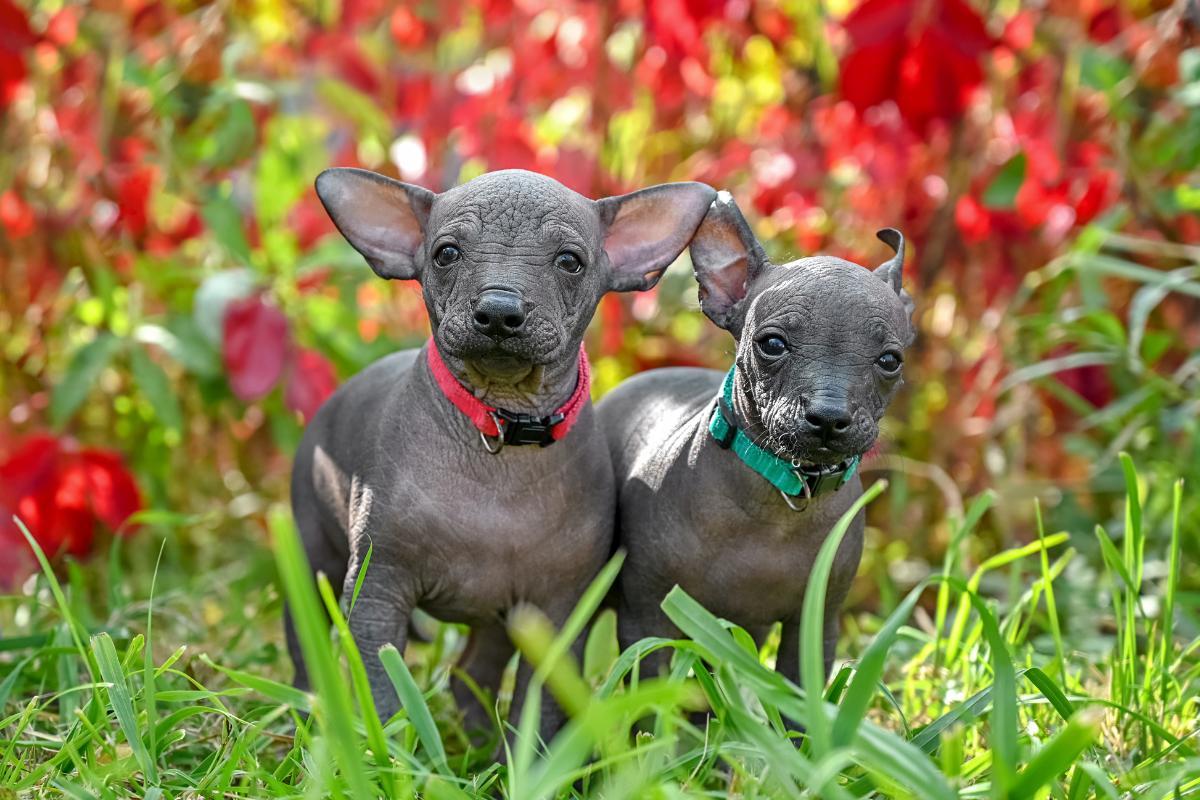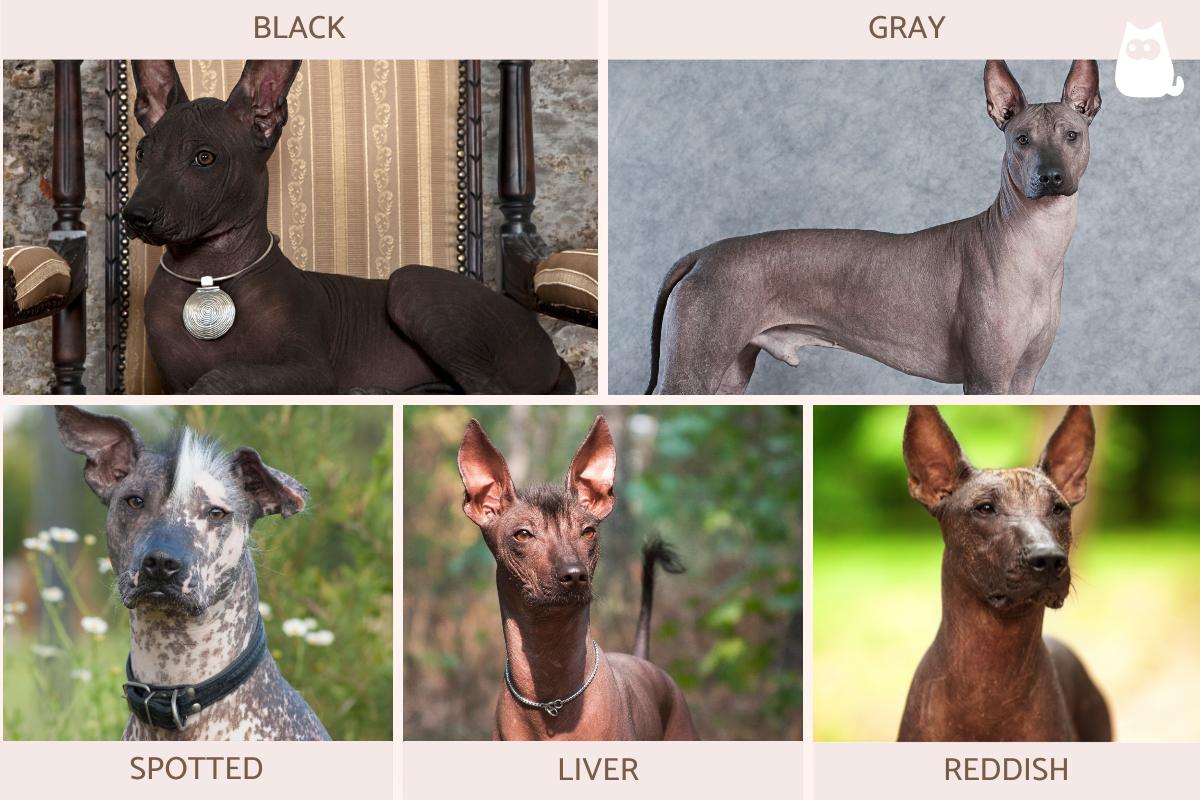Types of Xoloitzcuintle - Size and Coat



Animal file: Mexican Hairless Dog (Xoloitzcuintle)
The Xoloitzcuintle is a Mexican dog breed which is known as a type of hairless dog. In addition to being known as the Xoloitzcuintli or Xolo in its native land, it is often known as a Mexican hairless dog. This moniker is largely appropriate thanks to most Xoloitzcuintles lacking hair on the majority of their body. It is a distinctive trait, highlighting their thick skin which is now exposed to the elements. While this may be the most well-known of the Xolo types, there are other breed variations which differ according to different factors. There is even a type of Mexican hairless dog which does have a coat.
We share the types of Xoloitzcuintle according to size, coat and color. These types are accepted by the International Canine Federation (FCI), but it is important to remember there are other mixed-breed variations which are not included.
Types of Xoloitzcuintle according to size
The Xoloitzcuintle is an ancient dog which was revered by the Aztecs and other pre-Hispanic civilizations in Mexico. It was associated with the gods and almost became extinct until it was actively revived by the Mexican Kennel Club in the mid-20th century. Officially accept by the International Canine Federation in 1961, a breed standard has been set out which is used to set out the desired physical traits of an ideal specimen.
According to the FCI breed standard, these ancient Mexican dogs can be found in three different sizes:
- Miniature: also known as the toy Xoloitzcuintle, they can measure from 25 cm to 35 cm at the withers, with a body weight of between 2 and 7 kg.
- Medium or intermediate: height at the withers varies from 36 to 45 cm, while weight is between 7 and 14 kg.
- Standard: measures from 46 to 60 cm at the withers, but a variation of 2 cm is accepted in individuals of notable quality. The body weight can reach 18 kg.
While the standard is the largest type of Xoloitzcuintle, none of them are particularly big. In fact, all are consider types of small dog breeds. We can see their size in the photo below.
Historically, the Xoloitzcuintle was kept as a guard dog. They were also known to be eaten as a food by pre-Hispanic peoples. Only the toy Xoloitzcuintle variety was originally developed specifically as a companion animal.
Regardless of its size, the Xolo may look similar at first glance to the Peruvian Hairless Dog. They are different breeds with their own histories and traits. You can learn more about their similarities and differences with our article comparing the Peruvian Inca Orchid vs. Xoloitzcuintle differences.

Types of Xoloitzcuintle according to coat type
The hairless appearance of most Xoloitzcuintles is due to a random genetic mutation which occurred thousands of years ago. Xoloitzcuintles were originally coated before this genetic mutation, but the hairless variety is more common. This is because the hairless gene is dominant, but two copies of the dominant gene (the homozygous combination) is lethal and the embryos with this genetic expression do not develop. The remaining coated expression provides a minority of puppies.
Hairless Xoloitzcuintle dogs
As we have explained the hairless gene in Xoloitzcuintles is dominant. According to the FCI, it has been proven that crosses between hairless individuals contributes to the conservation and improvement of the breed. For this reason, it should be prioritized by breeders.
The identifying characteristic of this type of Xoloitzcuintle is the absence of hair covering its body. Despite this, it is common to observe small patches of hair on various parts of the body such as their forehead and nape of the neck. According to the breed standard, this hair should be no longer than 2.5 cm and should not form a topknot.
Due to the absence of fur, the skin of the hairless Xoloitzcuintle is particularly sensitive. Fortunately, it is thick and still plays a key role in protecting the body against parasites, dirt, adverse weather conditions and various pathogens. It is important to provide additional protection against the sun and cold. Many Xoloitzcuintle guardians use creams and ointments to provide this protection, just as long as it is safe for canine use.
Learn more about protecting your dog from environmental factors with our article on common skin diseases in dogs.
Coated Xoloitzcuintle
Although they are less common, there are Xoloitzcuintles with hair all over their body. They have the same physical and temperamental characteristics than hairless Xolos. The hair tends to be short and straight, becoming sparser on the belly and inner parts of the hind limbs. In addition to hair, the dominant/recessive gene expressions affect the teeth of these dogs. Hairless Xolos have poor dentition while coated Xolos have a full set of teeth.
In order to preserve the breed, crosses between two coated individuals are prohibited. In order to increase genetic diversity, crossing coated and hairless Xolos with a well-developed coat with hairless specimens is permitted.
Whether a Xoloitzcuintle is hairless or coated is not affected by size. Toy, intermediate and standard Xoloitzcuintles can be coated or hairless. You can see comparison photos of these Xoloitzcuintles below and discover other types of ancient Mexican dog breeds with our related article.

Types of Xoloitzcuintle according to color
According to the FCI breed standard, solid and dark colors are preferred in all types of Xoloitzcuintles dogs, whether haired or hairless. There are various shades that can occur in the skin and coat of these Mexican dogs, so this can also be a parameter for classifying them. In this sense, the most common colors in the Xoloitzcuintle that are accepted by the FCI are:
- Black
- Blackish gray
- Slate grey
- Dark grey
- Reddish
- Liver
- Bronze
- Blond
We share some of these Xolo color types in the photos below. In all types of Xoloitzcuintle colors, the presence of white or any other colored spots is allowed. These can appear on the coat or the skin, depending on whether they are hairless. If a hairless Xolo does have some small patches of hair, these are a different color from that of their skin.
With crossings of Xoloitzcuintle dogs, there are new coat patterns such as merle, brindle, bicolor or tricolor which are appearing. These are not accepted by the FCI. They may also provide certain genetic risks as these crossings for ‘designer’ dogs can pass on inheritable health problems.
In addition to the Xoloitzcuintle, take a look at the other types of hairless dog breeds you can find.

If you want to read similar articles to Types of Xoloitzcuintle - Size and Coat, we recommend you visit our Comparisons category.
- International Canine Federation. (FCI). Breed standard No. 234: XOLOITZCUINTLE (Hairless variety & Coated variety).
https://www.fci.be/en/nomenclature/XOLOITZCUINTLE-234.html








